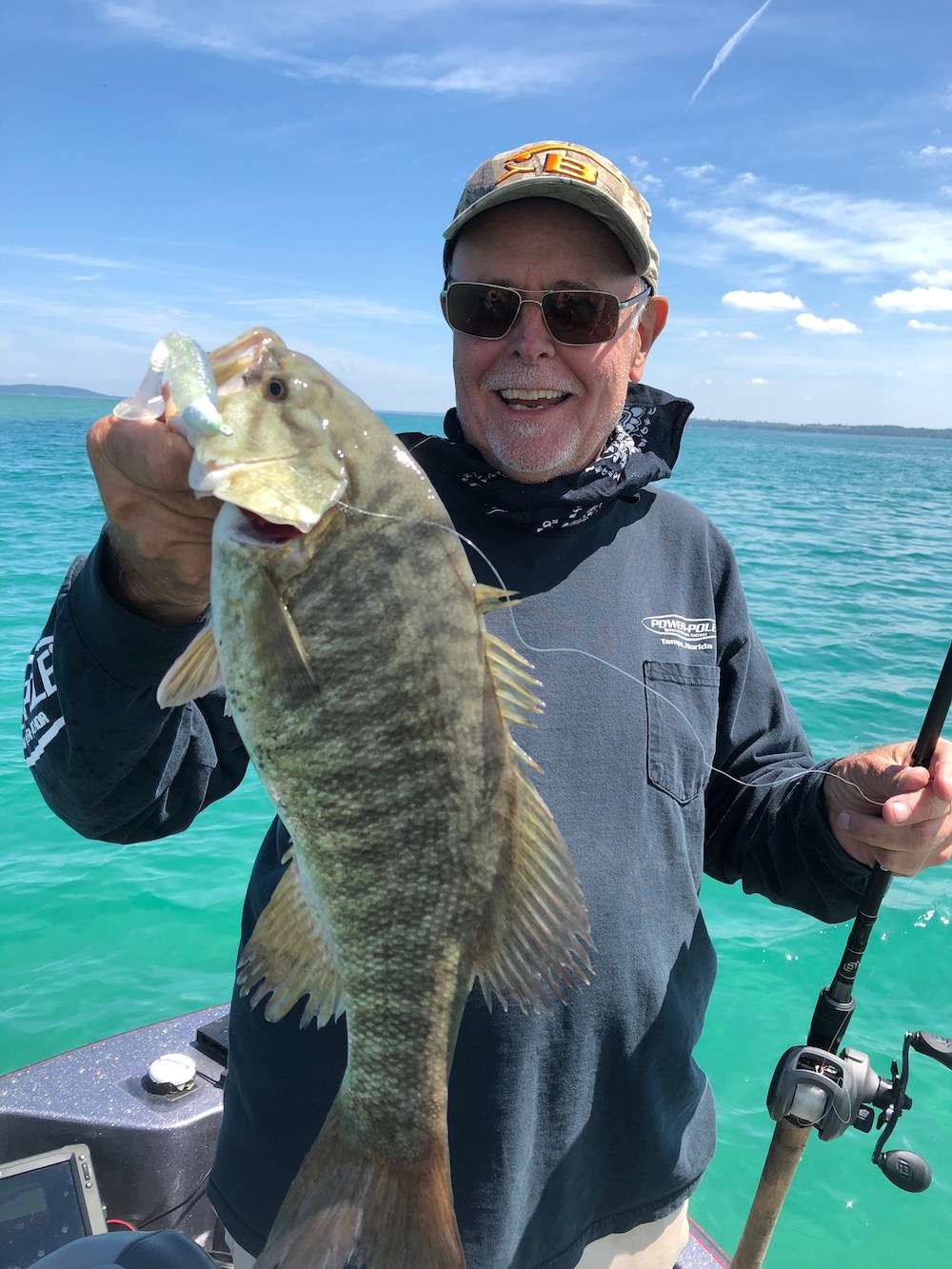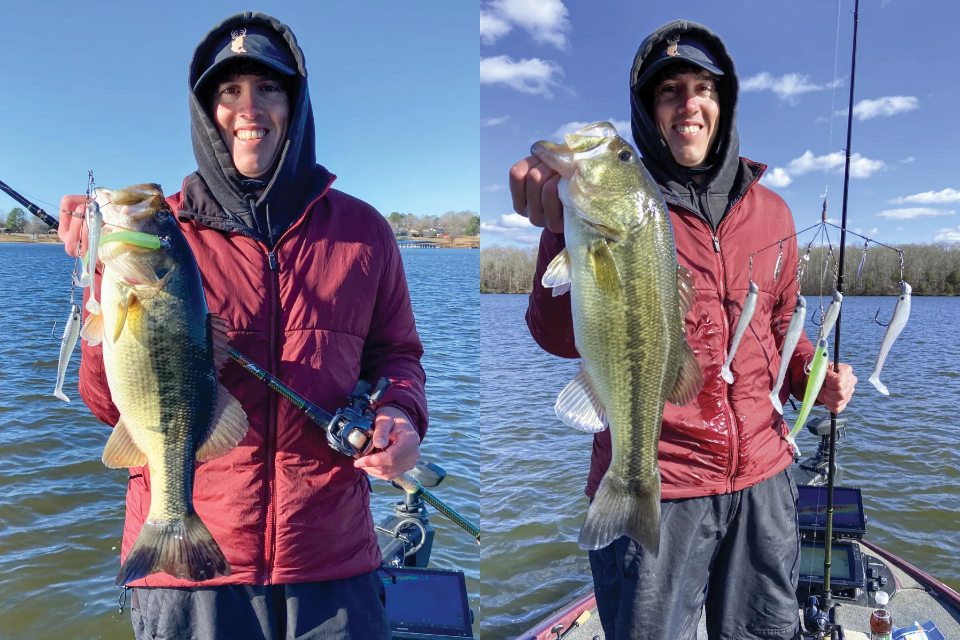
As part of a fifth-grade class project, Justin Hamner was assigned to write an essay on what he wanted to be when he grew up. His teacher was undoubtedly expecting many of the responses from boys in the classroom to be along the lines of “astronaut,” “doctor” or “firefighter,” but young Justin’s career aspiration was “pro bass fisherman,” and the inspirational role model he cited in his essay was Oregon pro Jay Yelas. “I was crazy about bass fishing when I was a kid,” Hamner recalled. “Besides fishing every chance I got, I devoured every issue of Bassmaster and followed the pro tournament standings closely. But when Jay Yelas won the 2002 Classic on Lay Lake near my home, that’s when I knew I wanted to fish for a living. Jay was such an awesome role model. Besides his incredible angling skills, I was impressed by his faith in God and what a class act he was.” Hamner’s lofty career goals appear to be on course — he qualified for the Elite Series in 2021, has already copped two Top 15 finishes and placed fourth in the 2022 Bassmaster Classic. And now he’s following in Yelas’ footsteps and taking Bassmaster’s prestigious Day on the Lake challenge! Can Hamner unlock the secrets of a mystery lake on a blustery winter day? You’re about to find out!
• 6:37 a.m. It’s 37 degrees, calm and breaking daylight as Hamner and I arrive at Lake M’s deserted boat launch. The pro arranges several Halo rods on his rig’s front deck. “This region has had lots of rain recently and I’m hoping the lake isn’t muddy. Winter is a great time to catch some really big bass as long as you’ve got decent water clarity.”
7 HOURS LEFT
• 7 a.m. We launch the Falcon. Hamner checks the water: It’s 49 degrees and only slightly murky. “Whew, that’s a relief! Cold, muddy water is the pits! Conditions look decent for my two favorite winter lures, a jerkbait and an A-Rig. (Note: A-Rigs, aka umbrella rigs, are illegal in Elite Series competition but permissible during DOTL outings.) The bite may be a bit slow due to this cold front, but if I can find some fish offshore relating to baitfish schools, I’m confident I can catch them.”
• 7:03 a.m. Hamner idles around Lake M’s lower end, eyeballing his electronics for baitfish and bass. “I’m not seeing a ton of bait, but I am seeing some scattered fish in the 10- to 15-foot zone. Hopefully, the bigger ones are bass.”
• 7:11 a.m. Hamner makes his first casts of the day to open water adjacent to Lake M’s dam with a shad pattern Yo-Zuri 3DB jerkbait. “There are a couple fish suspended way out here 15 feet deep. My game plan much of the day will probably be casting either a jerkbait or an A-Rig to suspending bass like these guys that I’ve located on my Garmin Panoptix LiveScope unit.”
• 7:31 a.m. Hamner switches to a True Bass umbrella rig equipped with five 3.25-inch NetBait Little Spanky swimbaits; four are shad-colored and the center lure is chartreuse. They’re rigged on 3/16-ounce jigheads. He casts the rig to open water, watches it sink on his electronics and slow rolls it past the fish.
• 7:37 a.m. Back to the jerkbait. “I haven’t seen any fish following my presentations so far. Hopefully, they’ll get more active once the sun gets higher.”
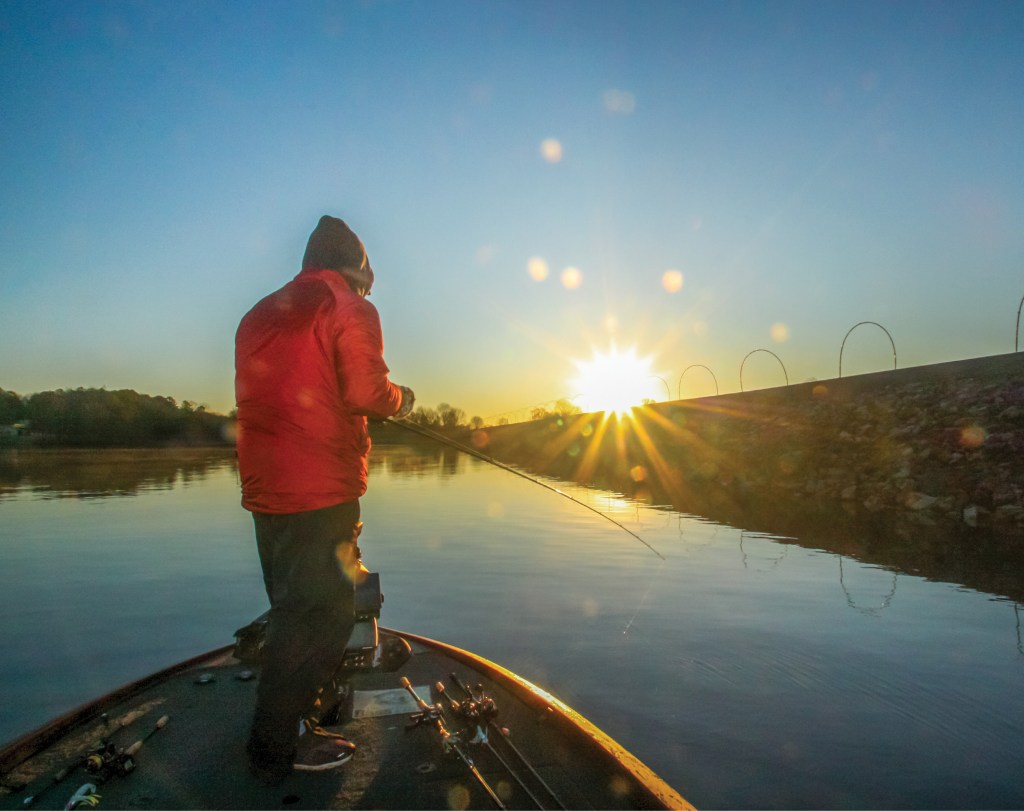
• 7:50 a.m. Hamner is staying two cast lengths off the dam, targeting suspending fish with the jerkbait and umbrella rig.
• 7:56 a.m. Hamner tries a 1/2-ounce chartreuse and white Z-Man ChatterBait bladed jig with a white NetBait Little Spanky trailer around a seawall.
6 HOURS LEFT
• 8 a.m. Hamner enters a cove with multiple docks and tries the jerkbait.
• 8:06 a.m. He switches to a 1/4-ounce Tennessee shad Yo-Zuri 3DB diving crankbait around docks.
• 8:08 a.m. Hamner bags a nonkeeper off a submerged brushpile on the jerkbait.
• 8:12 a.m. A frigid breeze is now blowing as Hamner jerks a crappie off the brushpile. “I’m seeing a lot of fish around that brush; at least now I know what they are.”
• 8:16 a.m. Hamner slow rolls the umbrella rig around a couple more submerged brushpiles.
• 8:31 a.m. Hamner has spent the last 15 minutes unsuccessfully fishing his way to the back of the cove with the umbrella rig, jerkbait and ChatterBait. He exits the cove and idles to a main-lake point, where he tries the umbrella rig.
• 8:35 a.m. A bass pecks the umbrella rig halfway back to the boat but doesn’t hook up.
• 8:39 a.m. Hamner’s LiveScope unit tracks a big fish following his umbrella rig to the boat, but it doesn’t strike.
• 8:42 a.m. He switches to the jerkbait and bags his first keeper largemouth of the day — 1 pound, 1 ounce. “This fish was in open water chasing baitfish.”
• 8:47 a.m. Hamner catches his second keeper, 1-4, on the umbrella rig. “Same deal as that first one. There’s a big school out there, but they look fairly small.”
• 8:49 a.m. The umbrella rig harvests Hamner’s third keeper, 1-12. “I am seeing a couple of bigger fish in that school, if I can just talk them into biting!”
• 8:54 a.m. Hamner idles to a submerged rockpile and catches keeper No. 4, 2-1, on the umbrella rig. “This rockpile looks like money! It’s 2 feet on top and 22 feet all around it. I just had a half-dozen fish follow the A-Rig off the spot where it breaks off into deep water.”
5 HOURS LEFT
• 9 a.m. Keeper No. 5, 2 pounds even, smacks the jerkbait near the rockpile. “Time to get busy and start culling!”
• 9:10 a.m. Hamner drags a 3/4-ounce green pumpkin/blue Freedom Tackle football jig with a green pumpkin NetBait Mini Kickin’ B trailer around the rockpile. No takers, however.
• 9:13 a.m. Hamner replaces the 3.25-inch lures on his umbrella rig with 4-inch True Bass Big Minner swimbaits, “so I can hopefully tempt some bigger fish to bite.”
• 9:22 a.m. Hamner has spent the last few minutes dragging the football jig around the rockpile — not his favorite presentation technique. “My jig-fishing patience is wearing thin!”
• 9:30 a.m. Hamner reverts to the umbrella rig and immediately nails his sixth keeper, a feisty 3-3 largemouth. “Yes! I watched this fish swim right off the rocks and cream it!”
• 9:36 a.m. A big fish strikes the umbrella rig but comes unbuttoned. “Dang, that was a giant! It followed the A-Rig right to the boat!”
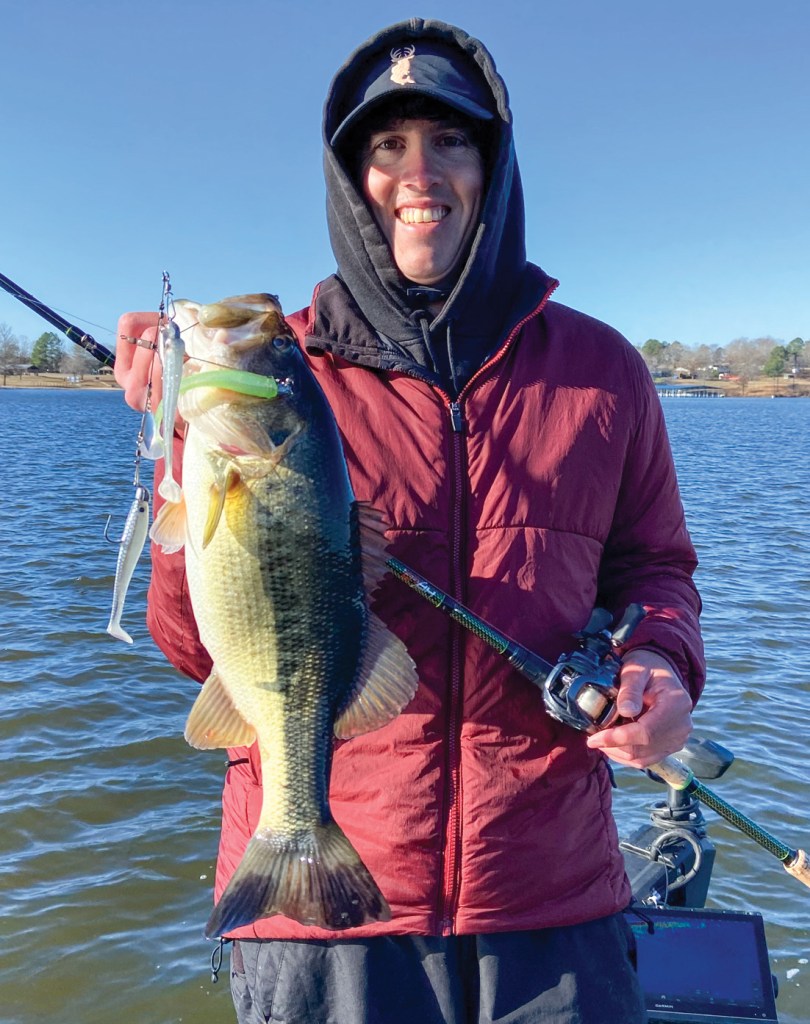
• 9:41 a.m. Hamner catches a beautiful 4-pound, 5-ounce bass off the rockpile on the umbrella rig. “There’s a classic food-chain scenario taking place here. The wind is causing plankton to drift into the rockpile; the shad are schooled up feeding on plankton; and the bass are eating the shad. Notice I didn’t say, ‘The wind is blowing the shad’ — wind doesn’t blow fish anywhere.”
• 9:43 a.m. Hamner hangs the umbrella rig in some submerged brush. He uses an extra-long lure retriever to reclaim the rig, but it’s damaged, so he replaces it with a new one and re-rigs with fresh swimbaits — a time-consuming process.
4 HOURS LEFT
• 10 a.m. Having completed assembly of a replacement umbrella rig, Hamner opts to also break out an 8-inch 3:16 Lure Co. Rising Son swimbait, which he douses with BaitFuel fish attractant. “Now that I know the size fish that are in this lake, I’m confident about throwing this big swimbait. I’ve caught some whales on it! Big bass are bad about just following a swimbait; BaitFuel helps turn followers into biters.”
• 10:16 a.m. The re-rigging is finally complete, allowing Hamner to get back to fishing. He flings the swimbait to a nearby point and gets a hard strike, but the fish shakes free. “Whoa! I think they’re going to like this bait!”
• 10:34 a.m. Hamner has saturated the point with the swimbait and umbrella rig with no further action. What’s his take on the day so far? “As I expected, the bass are relating loosely to deep points and transition banks and are roaming around open water, following scattered baitfish schools. With the cold front moving through, the wind has picked up, which has concentrated the bait more and activated the bass. I’ve spent the morning in the lake’s lower end, and the water here is already murkier than when we started due to storm runoff; this makes me not want to run way uplake where it’s probably muddy. I’ll stick mainly with the A-Rig and big swimbait during my remaining time and focus on triggering bites from big fish.”
• 10:40 a.m. Hamner moves to a steep channel bank lined with docks and tries the umbrella rig.
• 10:55 a.m. Hamner has fished the long stretch of channel bank without a bite. The wind has intensified and scattered clouds have appeared. “It’s definitely getting colder as that front moves through. I need to get on a pod of big fish before my window of opportunity slams shut!”
3 HOURS LEFT
• 11 a.m. Hamner tries the jerkbait around a seawall but hauls water.
• 11:13 a.m. Hamner has spent several minutes trying to get a huge suspending fish to bite his umbrella rig and swimbait, but the bass isn’t responding. “It’s frustrating and time consuming to see a giant on LiveScope and not get any reaction from it!”
• 11:28 a.m. Hamner rockets to the opposite side of Lake M and slow rolls the swimbait across a submerged tree. “I haven’t focused on submerged wood so far today; there should be some fish around deeper laydowns.”
• 11:36 a.m. A 1-pound keeper (No. 8) hits the umbrella rig; no help there.
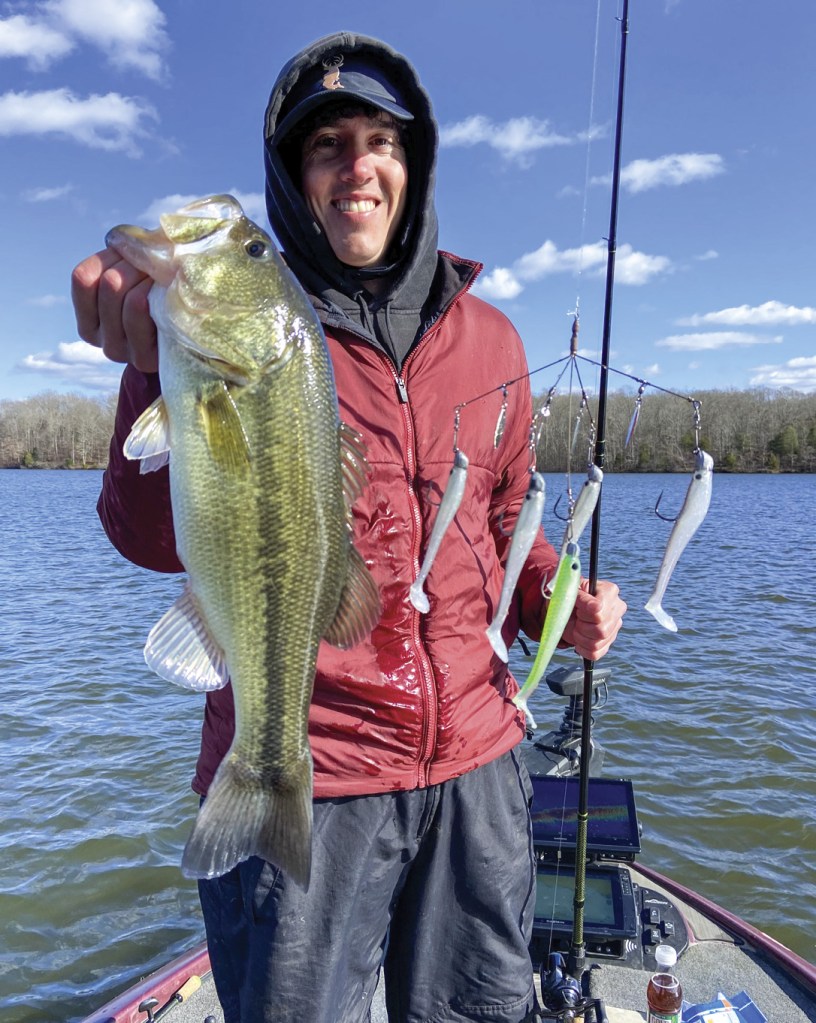
• 11:45 a.m. Hamner moves to a nearby point, idles around open water and locates a pod of quality fish. He casts the umbrella rig to the bass, and a big fish loads on! He works it to boatside and swings his ninth keeper aboard; it weighs 4 pounds, 2 ounces. “I finally found a big school of balled-up bait, and there are several big fish feeding on it. I could do some damage here.”
• 11:51 a.m. Still targeting the baitfish school with the umbrella rig, he catches a 1-7 keeper (No. 10); it’s a cull.
• 11:54 a.m. Hamner swims the umbrella rig through the bait school and his rod bows. He’s hooked two fish on the rig! His 11th and 12th keepers weigh 2-2 and 2-12. “No wonder I thought I’d hooked a giant!”
2 HOURS LEFT
◗ Noon. Still targeting the bait ball with the umbrella rig.
• 12:14 p.m. No more bites from this spot, so Hamner moves to another steep point with the umbrella rig.
• 12:18 p.m. He retrieves the swimbait past a submerged brushpile. “I’m seeing a load of fish there, but they’re probably crappie.”
• 12:26 p.m. Hamner idles a quarter-mile uplake, scanning his electronics for baitfish. “I’ve only seen one big, tight bait ball so far today. Most of the bait is scattered.”
• 12:40 p.m. Hamner runs back downlake to fish a small cove with several laydowns. He tries the jerkbait and ChatterBait here without success.
• 12:48 p.m. There’s an isolated laydown near the middle of the cove. Hamner slow rolls the swimbait past the cover without success. “There should have been one there!”
• 12:53 p.m. Hamner casts the swimbait to fish suspended over brushpiles in open water. Nothing there, either.
1 HOUR LEFT
• 1 p.m. There’s a marina close by, and Hamner opts to casts the big swimbait around empty boat slips. “There’s always some big fish around a marina — they’ve got deep water, cover, shade and an endless supply of bluegill to eat.”
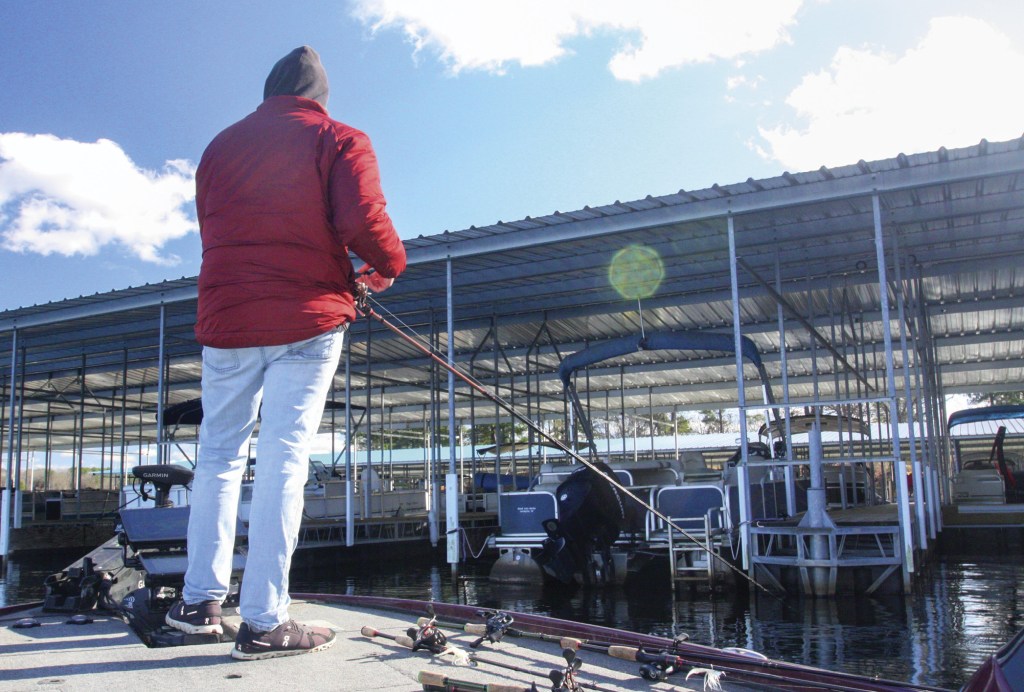
• 1:06 p.m. Hamner lobs the swimbait to an empty slip and a good fish grabs it! His 13th keeper weighs 3 pounds, 15 ounces.
• 1:15 p.m. The wind is howling as Hamner continues swimbaiting marina slips.
• 1:28 p.m. Hamner zips back to the rockpile he fished earlier. He slow rolls the umbrella rig down the structure, hangs it in deep submerged brush and breaks it off. “I don’t have time to rig a new one.”
• 1:34 p.m. Hamner scopes some suspending bass 40 yards off the rockpile, but the swimbait can’t entice a bite.
• 1:45 p.m. With 15 minutes remaining, Hamner speeds to a chunk rock bank and tries the swimbait and jerkbait. No takers here.
• 1:48 p.m. He bags a 1-4 cull (keeper No. 14) off a seawall on the jerkbait.
• 1:55 p.m. Hamner casts the swimbait parallel to dam riprap and gets a solid strike, but the fish doesn’t hook up. “No last-minute lunker for me!”
• 2 p.m. Time’s up! In spite of cold-front conditions, Hamner has had a great day on Lake M, catching 14 keeper largemouth. His five biggest bass weigh 18 pounds, 5 ounces.
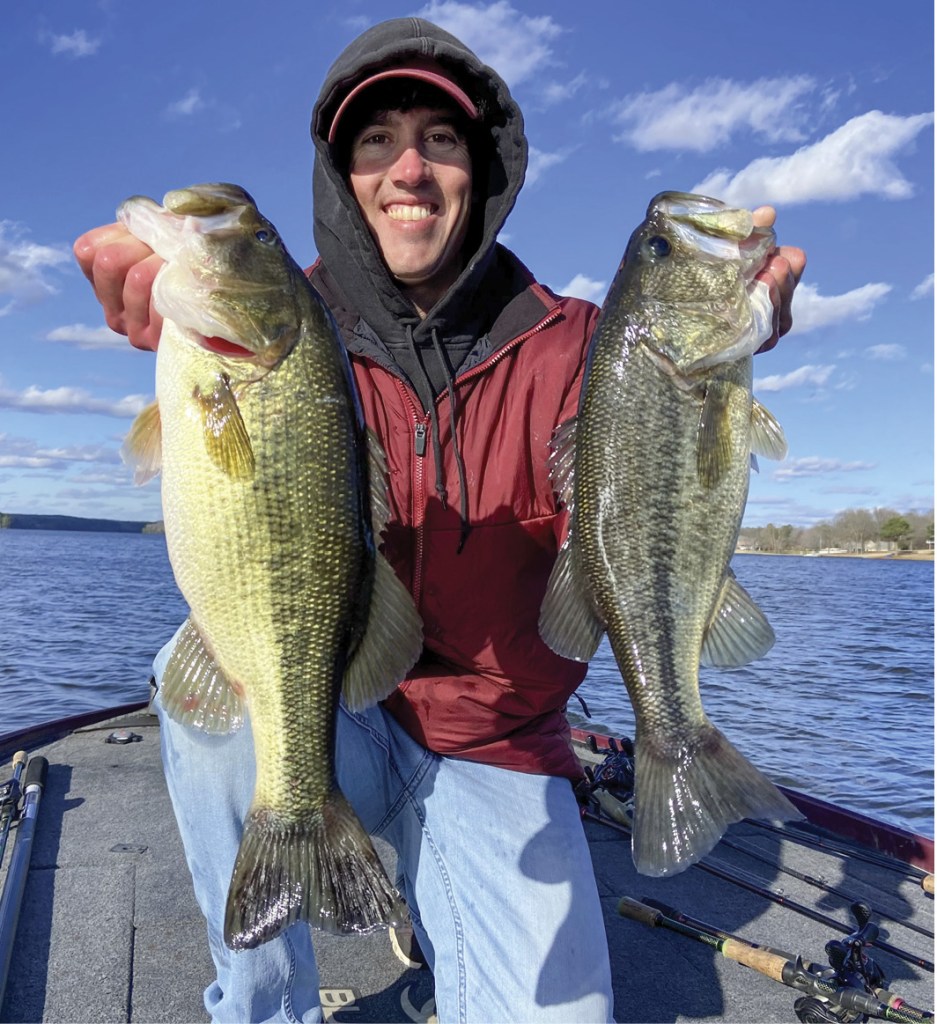
The Day In Perspective
“The day unfolded about like I expected, with bass mostly suspending around baitfish in open water adjacent to deep, main-lake structure,” Hamner told Bassmaster. “Forward-shooting sonar makes this common winter pattern a blast to fish; you can visually track your lure and actually watch the fish react to it. The bite activity peaked around 11:30 a.m. and tapered off dramatically after noon as the front passed through. It’s supposed to be considerably colder tomorrow; if I were to fish here then, I’d expect a slower bite, and that muddy runoff may have reached the lower end by then, in which case the A-Rig and swimbait could lose effectiveness and I might be forced to rely more on a jig or ChatterBait.“
Where and When Justin Caught His Five Biggest Bass
1. 3 pounds, 3 ounces; True Bass umbrella rig with five True Bass Big Minner 4-inch swimbaits (four shad color, one chartreuse color); submerged rockpile; 9:30 a.m.
2. 4 pounds, 5 ounces; same lure and place as No. 1; 9:41 a.m.
3. 4 pounds, 2 ounces; same lure as No. 1; open-water baitfish school near point; 11:45 a.m.
4. 2 pounds, 12 ounces; same lure as No. 1, same place as No. 3; 11:54 a.m.
5. 3 pounds, 15 ounces; 8-inch 3:16 Lure Co. Rising Son swimbait (shad color); marina slip; 1:06 p.m.
TOTAL: 18 POUNDS, 5 OUNCES

